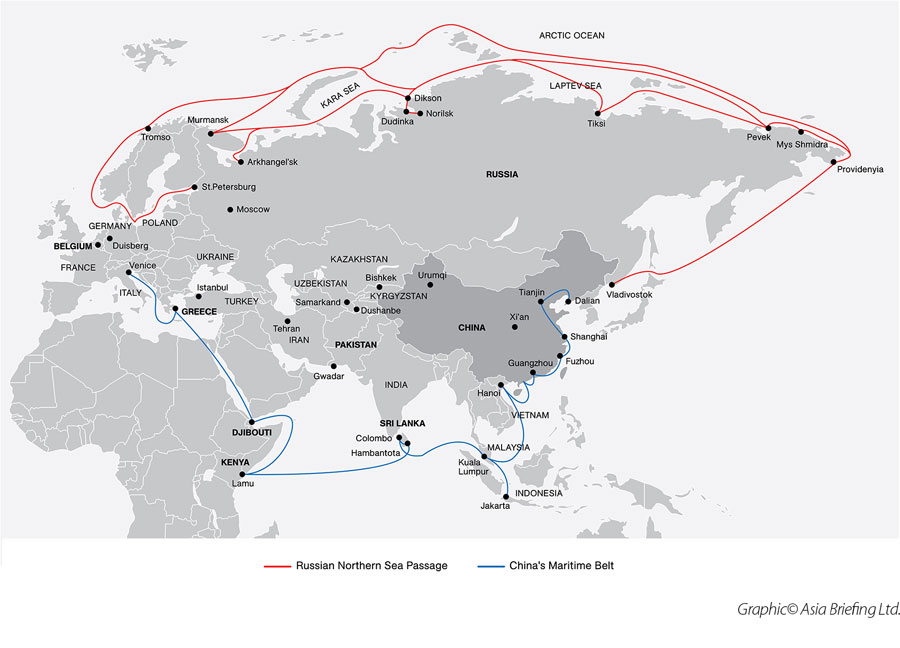Russia And China Encircle Eurasia By Adding The Northern Sea Passage To China’s Maritime Belt & Road
Op/Ed by Chris Devonshire-Ellis

Russia’s President Putin has suggested linking Russia’s Northern Sea Passage to China’s Maritime Belt & Road. The proposal, which was made at the 2nd Belt & Road Forum in Beijing last week, will reduce the shipping time and costs for Chinese goods to reach Europe by some two weeks, a huge saving on fuel and turnaround times. The route has already been commercially tested, Maersk ran a container ship from Vladivostok to St.Petersburg last summer.
President Putin said: “We pay great attention to the development of the Northern Sea Route. We are considering the possibility of uniting it with the Chinese Sea Silk Road, thereby creating a global and competitive route connecting north-eastern, eastern and south-eastern Asia with Europe.”
The proposal is likely to be warmly received in Beijing, which is actively looking to both improve supply chains and shipping routes to Europe, and reduce the costs in doing so. The main drawback is that much of the Russian port infrastructure in the Arctic needs significant infrastructure development and there will be significant costs attached to this, much of which China would be expected to fund. However, China will probably get around this by agreeing to purchase more oil and gas from Russia’s massive Siberian reserves to pay for the infrastructure build. Investing in Russia’s Northern sea passage then fully complies with China’s need to secure supply chains, and partially helps open up Siberia and the Russian Far East to Chinese goods, another criteria for China’s financing of Belt & Road projects. These regions contain a population of about 40 million people, equivalent to the opening up of a market the same size as Canada. However, the Russian Arctic region is also being looked at from a commercial viability perspective. Russian studies have indicated that the Arctic currently contributes about 10% of Russia’s annual GDP and about 20% of its exports, and has a total potential annual GDP value of US$500 billion by 2030. Russia has already budgeted US$86 billion for infrastructure development across the region to handle the perceived cargo and port facilities along the routes.
The various Naval capabilities across North-West Europe will of course be bigging up the threat and suggesting that large container ships could contain Chinese and Russian spying equipment and even weapons. That is part of the game when trying to extract larger defense budgets from national Governments. However, on the commercial side, there are significant opportunities for European infrastructure developers as well. Scandinavia is already preparing Arctic road and Arctic rail connections from Murmansk heading south, while the North-Western coast of Norway and Ports such as Tromso and Copenhagen could see a sizable increase in capacity is required.
About Us
Silk Road Briefing is produced and written by Dezan Shira & Associates. Chris Devonshire-Ellis is the practice Chairman. The firm advises foreign investors across China, ASEAN, India and Russia in addition to the Belt & Road Initiative, and has 28 offices across the region. Please contact our specialist Belt & Road team at silkroad@dezshira.com or visit us at www.dezshira.com
 Related Reading:
Related Reading:
![]() Russia, Norway to Develop Arctic Electric Road between Murmansk and Kirkenes
Russia, Norway to Develop Arctic Electric Road between Murmansk and Kirkenes
![]() The Northern Sea Passage Between Europe and Asia – Russia’s Developing Arctic Ports
The Northern Sea Passage Between Europe and Asia – Russia’s Developing Arctic Ports
![]() Russia’s Eurasian Economic Union Free Trade Agreement with Beijing Brings Chinese Goods to the EU Border
Russia’s Eurasian Economic Union Free Trade Agreement with Beijing Brings Chinese Goods to the EU Border





